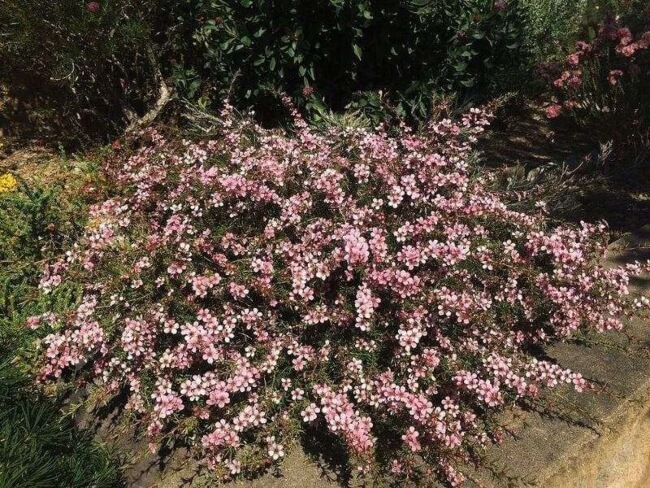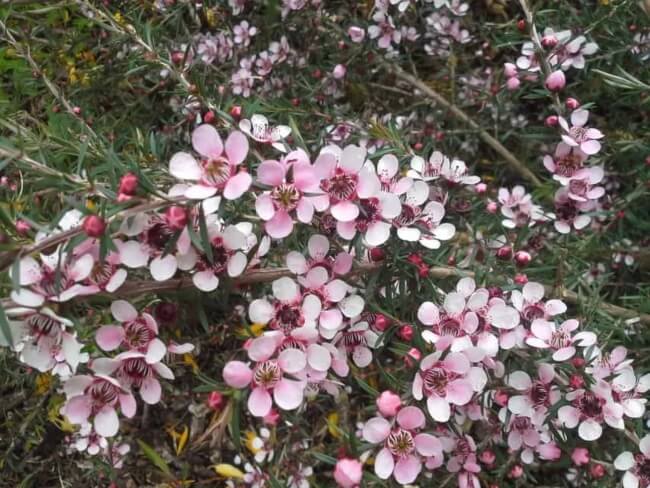Leptospermum ‘Pink Cascade’ is a tough and hardy shrub. Easy to care for and grow. It is a popular plant in Australia that can tolerate a range of soils and climate conditions. The arching and graceful cascade of branches explodes into a pretty display of pink flowers twice a year, in spring and autumn.
This gardening guide provides information on where to plant the tea tree pink cascade and how to grow and care for this native shrub.
More...
Botanical name: | Leptospermum ‘Pink Cascade’ |
|---|---|
Botanical family: | Myrtaceae |
What is Leptospermum ‘Pink Cascade’ ?

Source: Granton Plants
Leptospermum are a genus of shrubs and small trees commonly known as tea trees. This unusual common name came from the practice of early Australian settlers soaking the Leptospermum leaves in boiling water to make a tea substitute.
Leptospermum scoparium ‘Pink Cascade’ is an Australian cultivar that grows well in most regions of Australia. It is believed to be a hybrid between Leptospermum polygalifolium and Leptospermum continentale.
This compact, spreading perennial shrub grows to between 50-80 cm tall and 1.5 m wide. It has a dense foliage of narrow, straight, dark green leaves on weeping branches.
Established plants are heat and drought tolerant plants. They resist salt spray and do well in coastal climates. They can also withstand light frost. A tough shrub!
When Does Leptospermum ‘Pink Cascade’ Flower?
This tea tree generally produces masses of flowers in spring and autumn. When flowering, the twiggy canopy of small narrow leaves becomes covered in a pretty mass of showy pink flowers.
The five petalled flowers are small and about 1.5cm in diameter. Leptospermum ‘Pink Cascade’ flowers attract native birds, bees and other beneficial wildlife.
Growing Leptospermum ‘Pink Cascade’
Ideal Soil and Where to Position Your Pink Cascade
Pink Cascade tea trees prefer a light, moist well-drained soil. It will adapt to and tolerate a wide variety of soils, if well-drained.
The best spot for growing these natives in your garden is a sunny, well-drained position. They will also tolerate a semi shaded position in your garden, but this will impact the degree to which the plant flowers.
This shrub is often used as a hedge, screen or windbreak but works equally well as a feature plant in a bush or coastal garden given its pretty flowers. They are sometimes also planted successfully in rockeries. It works well and looks great in both scattered or mass plantings.
Leptospermum ‘Pink Cascade’ can also be grown in container pots. Try planting it with other Australian native shrubs like Grevillea sericea (Silky grevillea).
How to Care for Pink Cascade Tea Trees
Leptospermum ‘Pink Cascade’ is a hardy and low maintenance plant. It doesn’t require extra feed to thrive, but you can add a light sprinkling of blood and bone or a balanced native fertiliser once a year in spring to help flowering. They are also generally free from problems with pests and diseases.
Water regularly for about three months until the plant is established. Pink tea trees are drought-tolerant plants, so after that you can dial back the watering. Once established they rarely require watering except during extended dry periods. Mulch around the root zone which will help retain water.
You should trim these native plants occasionally to ensure they keep their shape, encourage flowering and to keep them tidy. The best time to trim Pink Cascade tea is after it has finished flowering in spring, which will promote a dense habit. Make sure not to cut into the old wood.
Now You Know How to Grow Leptospermum ‘Pink Cascade’
Leptospermum ‘Pink Cascade’ is a low maintenance and tough native plant which is ideal for most Australian gardens. Frost drought, salt and wind hardy. Once the plant is established, maintenance typically just involves semi-regular trim and watering during extended dry periods. It isn’t attacked by many pests or impacted by disease.
Enjoy the bountiful and stunning pink flowers! Contact us if you have any questions about how to grow Leptospermum ‘Pink Cascade’.
Published on August 24, 2023 by Gary Clarke
Last Updated on January 26, 2024






Greetings,
I live in Ipswich SEQ.
I have unsuccessfully tried growing a number of small Leptospermum shrubs. Most have died.They may have died due to extreme heat. The last shrub I planted was watered regulary and looked to be growing well however we were away for about three days in extreme hot weather and the plant died.
I don't specificially know that the plant died due to extreme hot weather. It was looking very healthy and suddenly died.
Maybe soil conditions? It is in a raised bed and the soil is free draining.
Kind regards
Walter Kite
Hi Walter,
Sorry to hear about your troubles, hopefully we can at least shed some light on it.
It was probably more to do with temperatures than soil. Leptospermums aren’t fussy about soil as long as it’s reasonably well drained. It’s a fascinating plant, in that there are some really detailed fossil records (forgive me in advance for the plant geek stuff to come…).
While Leptospermum scoparium (the species behind the ‘Pink Cascade’ cultivar) is technically native to Australia, it migrated to New Zealand in the late Oligocene or early Miocene era, at around the time when Australia became hotter, and drier. It literally moved across the ocean to find somewhere cooler, where temperatures were distinctly milder, and there was more of a difference between summer and winter.
The pink cultivars are particularly prone to suffering in the heat. If you need to replace them, choose a variety like Leptospermum macrocarpum ‘Copper Sheen’. It is native to NSW, and still thrive in the hotter summers.
Best regards,
Gary Clarke
Aussie Green Thumb
Mr Clarke thankyou for the information on the Tea Tree I had two some years back up here in the Upper Hunter but the drought claimed them when I was ill and couldn't tend the garde well so here I am endeavouring to bringt my garden back to some semblance of what it was having had some shade trees added in the last few years while recuperating…. I have bought TheBurgandy Queen and the Pink Cascade so far, the second for the front central garden and the Queen for a corner of the back on a high corner as I need a little shade for some plants nearby added… It will be a feature Shrub and will get all the winter sun and some direct spring and Autumn but will get some shelter from a nearby Jacaranda during summer heat. Thanks for your detailed information on growing and the varieties available … One I had before had deep pink edging on the flower I haven't seen that around as yet but then I have just started looking… Thanks for your experience with this plant.
Hi Dorothy,
Thanks for sharing your experiences, it’s always a joy to find out how plants are faring around the country. Your garden sounds wonderful, and about as well tended as it can be.
I always find that the garden forgives me when I’m out of action. Part of the joy is seeing how it does while I can’t tend to it, so I’m glad it gave you time to consider what was right for your patch.
Enjoy the rest of your year, and keep finding the beauty in the fine details, there’s loads of intricate beauty in the bark and young foliage of pink cascade in particular.
Best regards,
Gary Clarke